Rajeev Yasarla
Student Member, IEEE
RoCA: Robust Cross-Domain End-to-End Autonomous Driving
Jun 11, 2025Abstract:End-to-end (E2E) autonomous driving has recently emerged as a new paradigm, offering significant potential. However, few studies have looked into the practical challenge of deployment across domains (e.g., cities). Although several works have incorporated Large Language Models (LLMs) to leverage their open-world knowledge, LLMs do not guarantee cross-domain driving performance and may incur prohibitive retraining costs during domain adaptation. In this paper, we propose RoCA, a novel framework for robust cross-domain E2E autonomous driving. RoCA formulates the joint probabilistic distribution over the tokens that encode ego and surrounding vehicle information in the E2E pipeline. Instantiating with a Gaussian process (GP), RoCA learns a set of basis tokens with corresponding trajectories, which span diverse driving scenarios. Then, given any driving scene, it is able to probabilistically infer the future trajectory. By using RoCA together with a base E2E model in source-domain training, we improve the generalizability of the base model, without requiring extra inference computation. In addition, RoCA enables robust adaptation on new target domains, significantly outperforming direct finetuning. We extensively evaluate RoCA on various cross-domain scenarios and show that it achieves strong domain generalization and adaptation performance.
DySS: Dynamic Queries and State-Space Learning for Efficient 3D Object Detection from Multi-Camera Videos
Jun 11, 2025Abstract:Camera-based 3D object detection in Bird's Eye View (BEV) is one of the most important perception tasks in autonomous driving. Earlier methods rely on dense BEV features, which are costly to construct. More recent works explore sparse query-based detection. However, they still require a large number of queries and can become expensive to run when more video frames are used. In this paper, we propose DySS, a novel method that employs state-space learning and dynamic queries. More specifically, DySS leverages a state-space model (SSM) to sequentially process the sampled features over time steps. In order to encourage the model to better capture the underlying motion and correspondence information, we introduce auxiliary tasks of future prediction and masked reconstruction to better train the SSM. The state of the SSM then provides an informative yet efficient summarization of the scene. Based on the state-space learned features, we dynamically update the queries via merge, remove, and split operations, which help maintain a useful, lean set of detection queries throughout the network. Our proposed DySS achieves both superior detection performance and efficient inference. Specifically, on the nuScenes test split, DySS achieves 65.31 NDS and 57.4 mAP, outperforming the latest state of the art. On the val split, DySS achieves 56.2 NDS and 46.2 mAP, as well as a real-time inference speed of 33 FPS.
Distilling Multi-modal Large Language Models for Autonomous Driving
Jan 16, 2025Abstract:Autonomous driving demands safe motion planning, especially in critical "long-tail" scenarios. Recent end-to-end autonomous driving systems leverage large language models (LLMs) as planners to improve generalizability to rare events. However, using LLMs at test time introduces high computational costs. To address this, we propose DiMA, an end-to-end autonomous driving system that maintains the efficiency of an LLM-free (or vision-based) planner while leveraging the world knowledge of an LLM. DiMA distills the information from a multi-modal LLM to a vision-based end-to-end planner through a set of specially designed surrogate tasks. Under a joint training strategy, a scene encoder common to both networks produces structured representations that are semantically grounded as well as aligned to the final planning objective. Notably, the LLM is optional at inference, enabling robust planning without compromising on efficiency. Training with DiMA results in a 37% reduction in the L2 trajectory error and an 80% reduction in the collision rate of the vision-based planner, as well as a 44% trajectory error reduction in longtail scenarios. DiMA also achieves state-of-the-art performance on the nuScenes planning benchmark.
ToSA: Token Selective Attention for Efficient Vision Transformers
Jun 13, 2024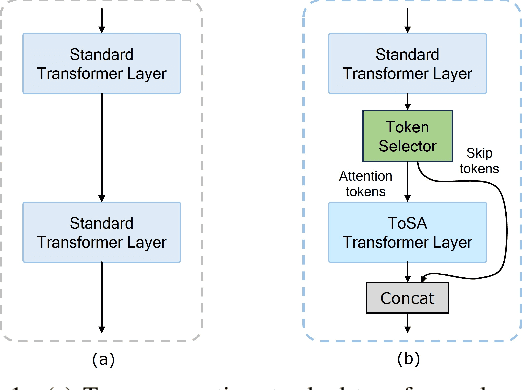

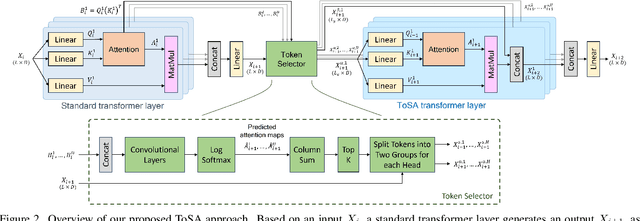

Abstract:In this paper, we propose a novel token selective attention approach, ToSA, which can identify tokens that need to be attended as well as those that can skip a transformer layer. More specifically, a token selector parses the current attention maps and predicts the attention maps for the next layer, which are then used to select the important tokens that should participate in the attention operation. The remaining tokens simply bypass the next layer and are concatenated with the attended ones to re-form a complete set of tokens. In this way, we reduce the quadratic computation and memory costs as fewer tokens participate in self-attention while maintaining the features for all the image patches throughout the network, which allows it to be used for dense prediction tasks. Our experiments show that by applying ToSA, we can significantly reduce computation costs while maintaining accuracy on the ImageNet classification benchmark. Furthermore, we evaluate on the dense prediction task of monocular depth estimation on NYU Depth V2, and show that we can achieve similar depth prediction accuracy using a considerably lighter backbone with ToSA.
FutureDepth: Learning to Predict the Future Improves Video Depth Estimation
Mar 19, 2024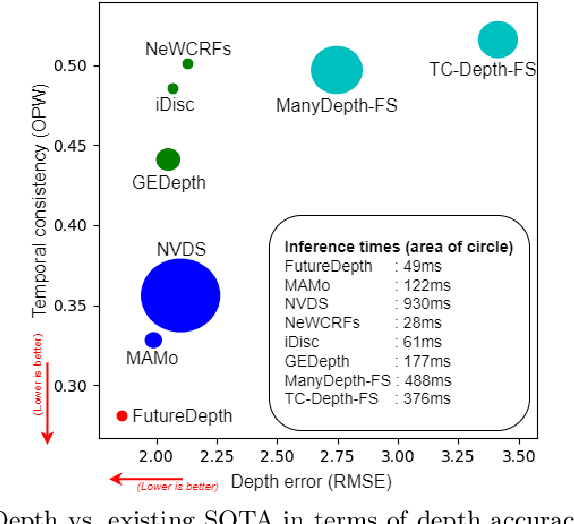
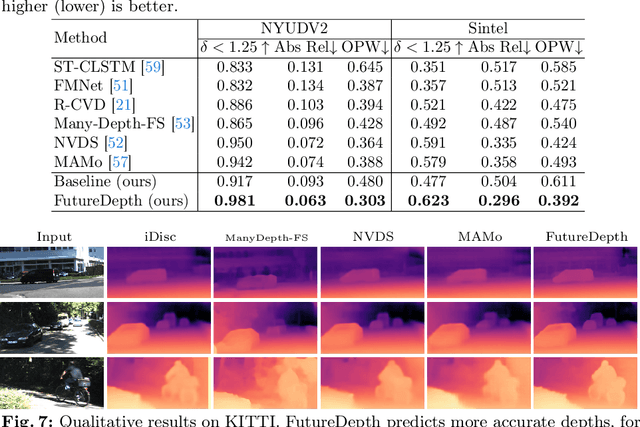

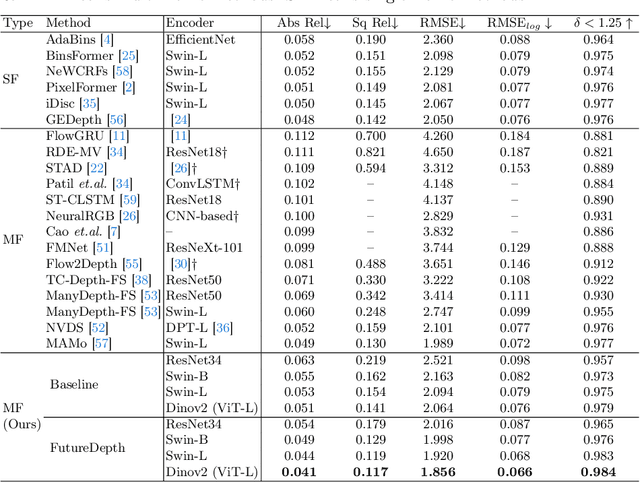
Abstract:In this paper, we propose a novel video depth estimation approach, FutureDepth, which enables the model to implicitly leverage multi-frame and motion cues to improve depth estimation by making it learn to predict the future at training. More specifically, we propose a future prediction network, F-Net, which takes the features of multiple consecutive frames and is trained to predict multi-frame features one time step ahead iteratively. In this way, F-Net learns the underlying motion and correspondence information, and we incorporate its features into the depth decoding process. Additionally, to enrich the learning of multiframe correspondence cues, we further leverage a reconstruction network, R-Net, which is trained via adaptively masked auto-encoding of multiframe feature volumes. At inference time, both F-Net and R-Net are used to produce queries to work with the depth decoder, as well as a final refinement network. Through extensive experiments on several benchmarks, i.e., NYUDv2, KITTI, DDAD, and Sintel, which cover indoor, driving, and open-domain scenarios, we show that FutureDepth significantly improves upon baseline models, outperforms existing video depth estimation methods, and sets new state-of-the-art (SOTA) accuracy. Furthermore, FutureDepth is more efficient than existing SOTA video depth estimation models and has similar latencies when comparing to monocular models
HexaGen3D: StableDiffusion is just one step away from Fast and Diverse Text-to-3D Generation
Jan 15, 2024Abstract:Despite the latest remarkable advances in generative modeling, efficient generation of high-quality 3D assets from textual prompts remains a difficult task. A key challenge lies in data scarcity: the most extensive 3D datasets encompass merely millions of assets, while their 2D counterparts contain billions of text-image pairs. To address this, we propose a novel approach which harnesses the power of large, pretrained 2D diffusion models. More specifically, our approach, HexaGen3D, fine-tunes a pretrained text-to-image model to jointly predict 6 orthographic projections and the corresponding latent triplane. We then decode these latents to generate a textured mesh. HexaGen3D does not require per-sample optimization, and can infer high-quality and diverse objects from textual prompts in 7 seconds, offering significantly better quality-to-latency trade-offs when comparing to existing approaches. Furthermore, HexaGen3D demonstrates strong generalization to new objects or compositions.
MAMo: Leveraging Memory and Attention for Monocular Video Depth Estimation
Jul 26, 2023Abstract:We propose MAMo, a novel memory and attention frame-work for monocular video depth estimation. MAMo can augment and improve any single-image depth estimation networks into video depth estimation models, enabling them to take advantage of the temporal information to predict more accurate depth. In MAMo, we augment model with memory which aids the depth prediction as the model streams through the video. Specifically, the memory stores learned visual and displacement tokens of the previous time instances. This allows the depth network to cross-reference relevant features from the past when predicting depth on the current frame. We introduce a novel scheme to continuously update the memory, optimizing it to keep tokens that correspond with both the past and the present visual information. We adopt attention-based approach to process memory features where we first learn the spatio-temporal relation among the resultant visual and displacement memory tokens using self-attention module. Further, the output features of self-attention are aggregated with the current visual features through cross-attention. The cross-attended features are finally given to a decoder to predict depth on the current frame. Through extensive experiments on several benchmarks, including KITTI, NYU-Depth V2, and DDAD, we show that MAMo consistently improves monocular depth estimation networks and sets new state-of-the-art (SOTA) accuracy. Notably, our MAMo video depth estimation provides higher accuracy with lower latency, when omparing to SOTA cost-volume-based video depth models.
NBD-GAP: Non-Blind Image Deblurring Without Clean Target Images
Sep 20, 2022



Abstract:In recent years, deep neural network-based restoration methods have achieved state-of-the-art results in various image deblurring tasks. However, one major drawback of deep learning-based deblurring networks is that large amounts of blurry-clean image pairs are required for training to achieve good performance. Moreover, deep networks often fail to perform well when the blurry images and the blur kernels during testing are very different from the ones used during training. This happens mainly because of the overfitting of the network parameters on the training data. In this work, we present a method that addresses these issues. We view the non-blind image deblurring problem as a denoising problem. To do so, we perform Wiener filtering on a pair of blurry images with the corresponding blur kernels. This results in a pair of images with colored noise. Hence, the deblurring problem is translated into a denoising problem. We then solve the denoising problem without using explicit clean target images. Extensive experiments are conducted to show that our method achieves results that are on par to the state-of-the-art non-blind deblurring works.
Learning to restore images degraded by atmospheric turbulence using uncertainty
Jul 07, 2022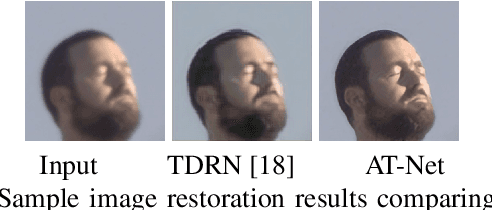


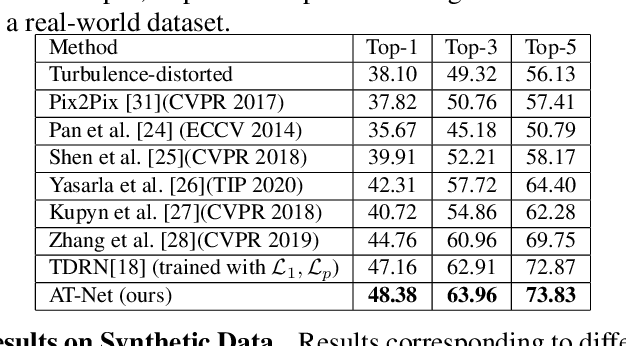
Abstract:Atmospheric turbulence can significantly degrade the quality of images acquired by long-range imaging systems by causing spatially and temporally random fluctuations in the index of refraction of the atmosphere. Variations in the refractive index causes the captured images to be geometrically distorted and blurry. Hence, it is important to compensate for the visual degradation in images caused by atmospheric turbulence. In this paper, we propose a deep learning-based approach for restring a single image degraded by atmospheric turbulence. We make use of the epistemic uncertainty based on Monte Carlo dropouts to capture regions in the image where the network is having hard time restoring. The estimated uncertainty maps are then used to guide the network to obtain the restored image. Extensive experiments are conducted on synthetic and real images to show the significance of the proposed work. Code is available at : https://github.com/rajeevyasarla/AT-Net
Unsupervised Restoration of Weather-affected Images using Deep Gaussian Process-based CycleGAN
Apr 23, 2022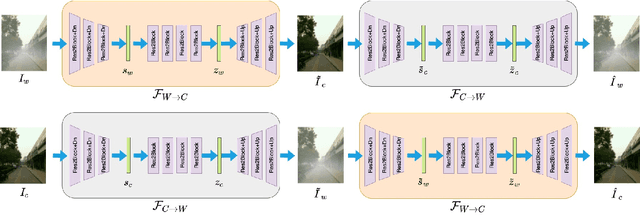
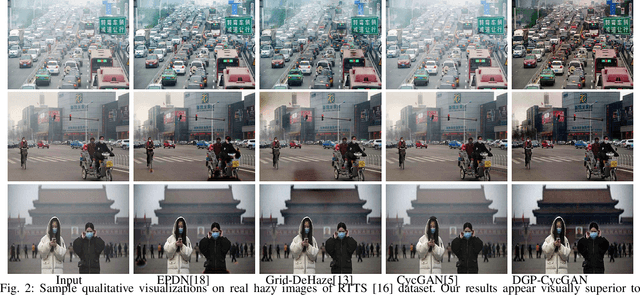


Abstract:Existing approaches for restoring weather-degraded images follow a fully-supervised paradigm and they require paired data for training. However, collecting paired data for weather degradations is extremely challenging, and existing methods end up training on synthetic data. To overcome this issue, we describe an approach for supervising deep networks that are based on CycleGAN, thereby enabling the use of unlabeled real-world data for training. Specifically, we introduce new losses for training CycleGAN that lead to more effective training, resulting in high-quality reconstructions. These new losses are obtained by jointly modeling the latent space embeddings of predicted clean images and original clean images through Deep Gaussian Processes. This enables the CycleGAN architecture to transfer the knowledge from one domain (weather-degraded) to another (clean) more effectively. We demonstrate that the proposed method can be effectively applied to different restoration tasks like de-raining, de-hazing and de-snowing and it outperforms other unsupervised techniques (that leverage weather-based characteristics) by a considerable margin.
 Add to Chrome
Add to Chrome Add to Firefox
Add to Firefox Add to Edge
Add to Edge